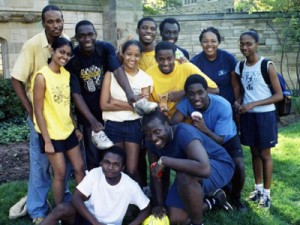(Pictured below: Members of the Yale University African Students’ Association. Yale is ranked #4 on the Forbes list of colleges that have produced the greatest number of billionaires)

“I am not impressed by the Ivy League establishments. Of course they graduate the best – it’s all they’ll take, leaving to others the problem of educating the country. They will give you an education the way the banks will give you money – provided you can prove to their satisfaction that you don’t need it.” ~Peter DeVries
* * *
Earlier last week, Forbes Magazine published it’s list of those colleges that have achieved the dubious distinction of producing the greatest number of billionaires. They are, in order of billionaires produced:
1. Harvard University (50 billionaires)
2. Stanford University (30)
3. The University of Pennsylvania (27)
4. Yale University (19)
5. Columbia University (15)
6. Princeton University (13)
7. New York University and The University of Chicago (tied at 10 billionaires each)
9. Cornell University; Massachusetts Institute of Technology; Northwestern University; University of California, Berkeley; University of California, Los Angeles; University of Southern California (tied at 9 billionaires each)
If the accumulation of massive net worth can be considered a measure of success and if one’s success can be even partially attributed to one’s college education, then it will probably come as no surprise that five of the top six colleges that made the Forbes list belong to the Ivy League, that storied sisterhood of impossibly selective, shamelessly well-endowed private universities.
So, what is it about these schools that causes them to produce such unusual numbers of extremely — even excessively — wealthy people? Have the colleges and universities of the Ivy League, most of which are as much as 100 years older than most of their oldest non-Ivy counterparts, simply had more time to hone and perfect the fine art of educating America’s youth? Do their outsized endowments draw the some of best teachers, stock many of the largest and most complete libraries, and provide for the richest array of educational resources and student support services? The answer to both of these questions is, with some qualifications, largely true.
But can the ability to produce many of the nation’s highest earners be simply attributed to the resources (faculty, library volumes, advising and support services) that an institution has to offer. Maybe it is simply that the combination of all of these resources and assets draws a population of students already poised to move into positions of power and wealth. Peter DeVries, author of the quote that begins this post, would agree with this conclusion. He is unimpressed by the Ivy League’s capacity to educate, largely because he believes isn’t that hard to educate students who are already — through happenstance of birth (a.k.a. luck), talent, aptitude, or due to the strength of their high school educations — poised excel at the college level.
If we are to follow DeVries’s line of reasoning, then the institutions most deserving of praise are those which successfully educate students from a wide range of backgrounds and a variety of levels of preparation. I suppose the question can be posed this way: which is the better teaching institution, the one that teaches calculus to students who scored 700 or above on the math SAT, or the one whose programs and support systems successfully create mathematicians out of students who enter with only remedial coursework in that field.
This analysis of the relationship between student preparedness and the effectiveness of a given college’s curriculum and academic and personal support programs would position HBCUs high among the strongest and most valuable teaching institutions in the country. The greatest strength of the HBCUs is their faith in and ability to effectively educate even those students whow enter college underprepared and/or from school districts in crisis.
Posted by Ajuan Mance
You can read the entire text of the Forbes article, “The Billionaire Universities,” at THIS link.









